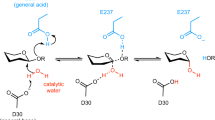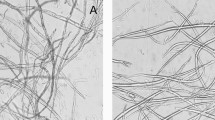Abstract
THE determination of the crystal structure of phloroglucitol dihydrate, besides establishing the fact that the α-phloroglucitol molecule has the configuration x,x,x, shows that the water molecules are chiefly responsible for the cohesion of the organic molecules in the lattice1. The structure is rhombohedral, and in the (111) planes equilateral triangles of hydroxylic oxygens are formed, each of the three oxygen atoms belonging to a separate phloroglucitol molecule. On the line perpendicular to the plane of the triangles and joining the centres of two triangles, two water molecules are situated ; and the distance from each water oxygen to the nearest three alcoholic oxygens and also the distance between the two water oxygen atoms is about 2·75 A. It is obvious, therefore, that the bonds linking together the group are hydrogen bonds.
This is a preview of subscription content, access via your institution
Access options
Subscribe to this journal
Receive 51 print issues and online access
$199.00 per year
only $3.90 per issue
Buy this article
- Purchase on Springer Link
- Instant access to full article PDF
Prices may be subject to local taxes which are calculated during checkout
Similar content being viewed by others
References
Andersen, Per, and Hassel, O., Acta Chem. Scand., 2, 527 (1948).
Author information
Authors and Affiliations
Rights and permissions
About this article
Cite this article
ANDERSEN, P., HASSEL, O. Phloroglucitol Diammoniacate, C6H9(OH)3.2NH3. Nature 163, 721–722 (1949). https://doi.org/10.1038/163721b0
Issue Date:
DOI: https://doi.org/10.1038/163721b0
Comments
By submitting a comment you agree to abide by our Terms and Community Guidelines. If you find something abusive or that does not comply with our terms or guidelines please flag it as inappropriate.



